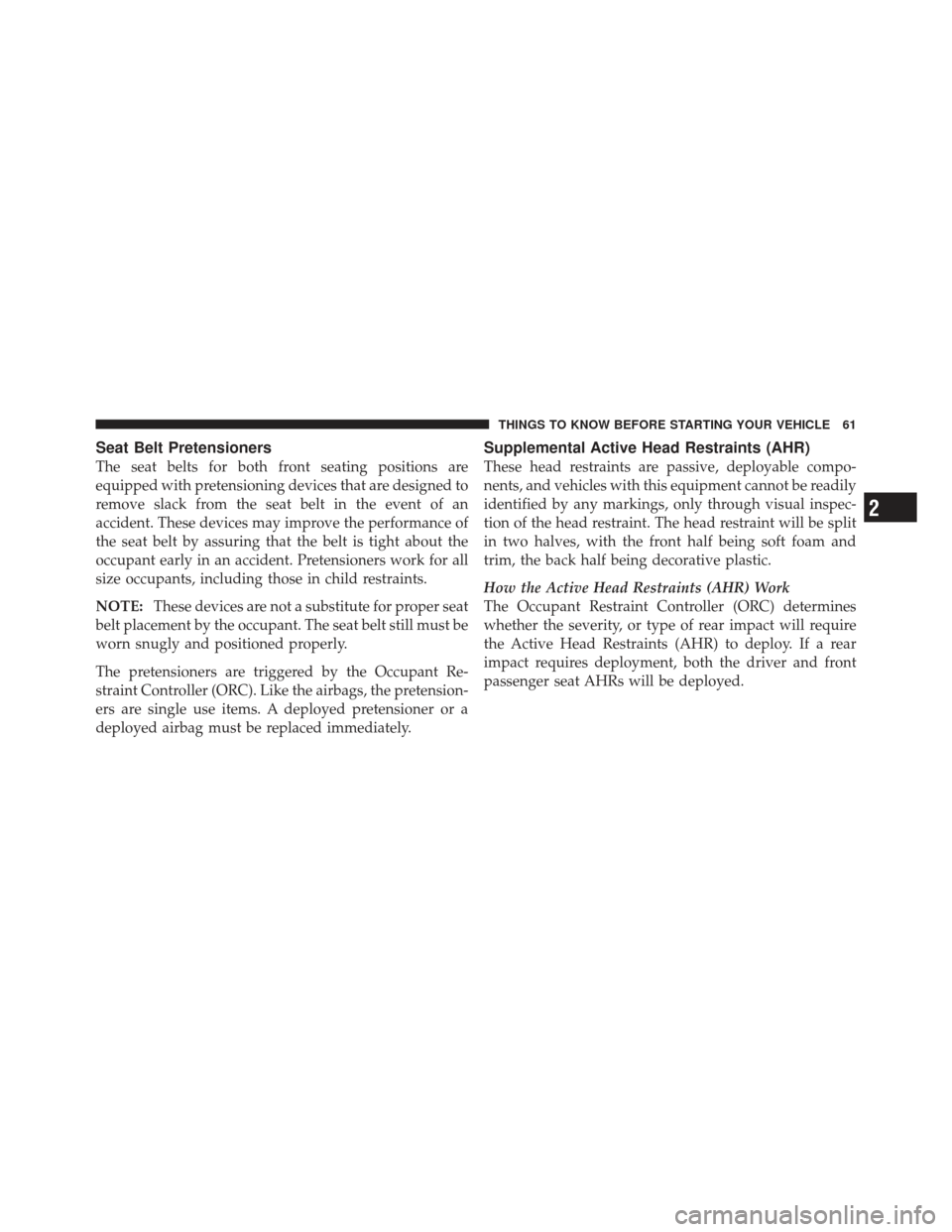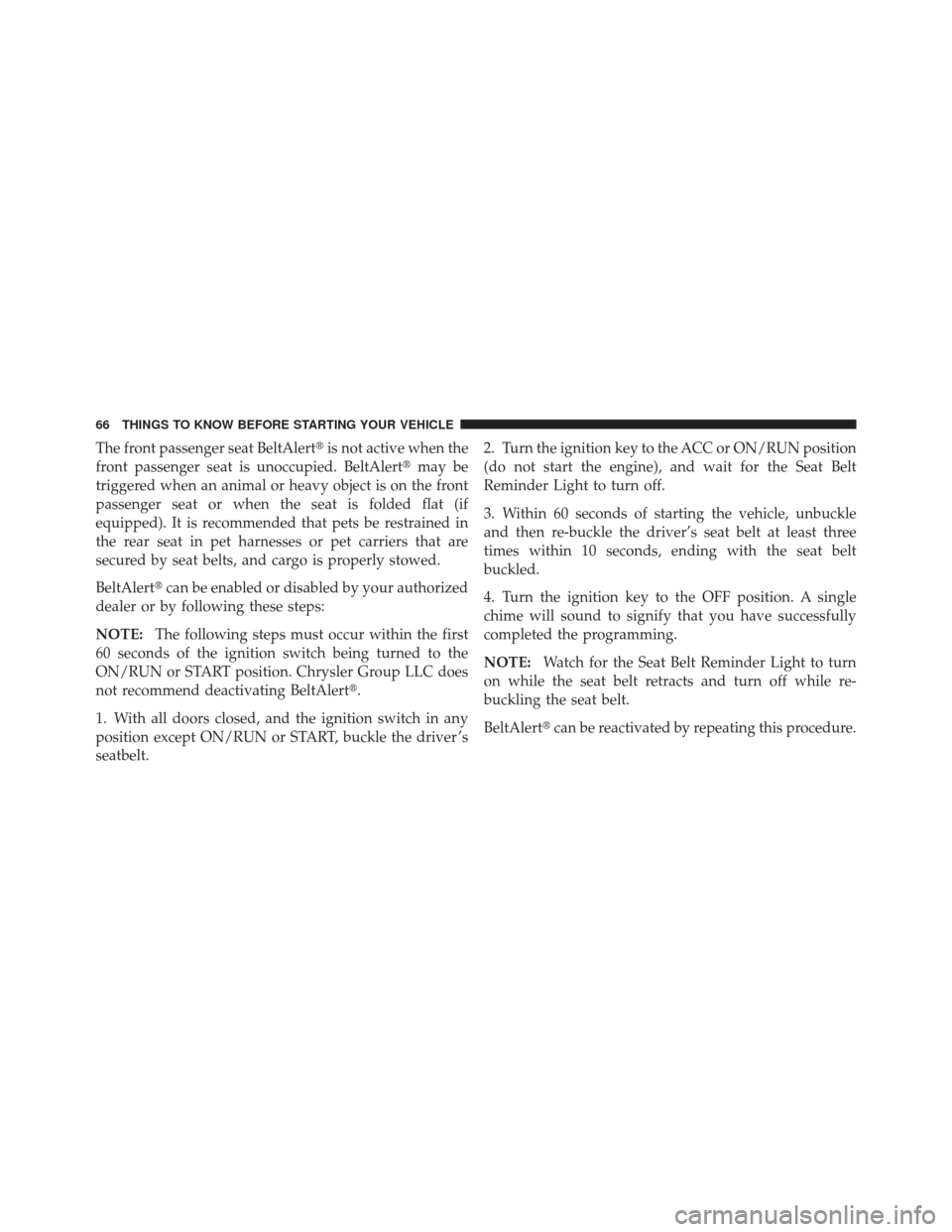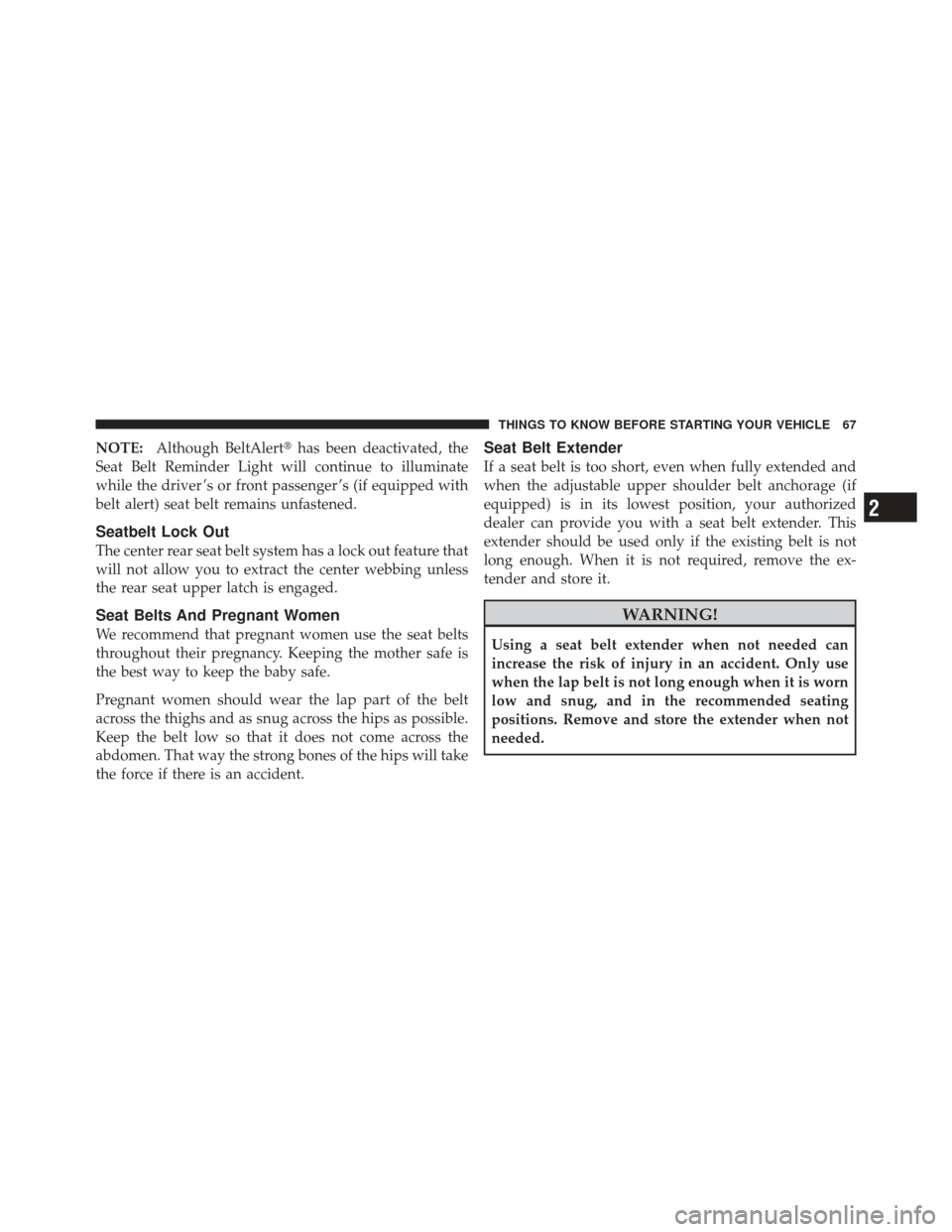Page 63 of 587

Seat Belt Pretensioners
The seat belts for both front seating positions are
equipped with pretensioning devices that are designed to
remove slack from the seat belt in the event of an
accident. These devices may improve the performance of
the seat belt by assuring that the belt is tight about the
occupant early in an accident. Pretensioners work for all
size occupants, including those in child restraints.
NOTE:These devices are not a substitute for proper seat
belt placement by the occupant. The seat belt still must be
worn snugly and positioned properly.
The pretensioners are triggered by the Occupant Re-
straint Controller (ORC). Like the airbags, the pretension-
ers are single use items. A deployed pretensioner or a
deployed airbag must be replaced immediately.
Supplemental Active Head Restraints (AHR)
These head restraints are passive, deployable compo-
nents, and vehicles with this equipment cannot be readily
identified by any markings, only through visual inspec-
tion of the head restraint. The head restraint will be split
in two halves, with the front half being soft foam and
trim, the back half being decorative plastic.
How the Active Head Restraints (AHR) Work
The Occupant Restraint Controller (ORC) determines
whether the severity, or type of rear impact will require
the Active Head Restraints (AHR) to deploy. If a rear
impact requires deployment, both the driver and front
passenger seat AHRs will be deployed.
2
THINGS TO KNOW BEFORE STARTING YOUR VEHICLE 61
Page 67 of 587

NOTE:
•If you have difficulties or problems resetting the
Active Head Restraints, see an authorized dealer.
•For safety reasons, have the Active Head Restraints
checked by a qualified specialist at an authorized
dealer.
Enhanced Seat Belt Use Reminder System
(BeltAlert�)
BeltAlert�is a feature intended to remind the driver and
front passenger (if equipped with front passenger
BeltAlert�) to fasten their seatbelts. This feature is active
whenever the ignition is on. If the driver or front seat
passenger is unbelted, the Seat Belt Reminder Light will
turn on and remain on until both front seatbelts are
fastened. BeltAlert� triggers within 60 seconds of vehicle
speed over 5 mph (8 km/h). The reminder sequence lasts
for 96 seconds or until the respective seatbelts are fas-
tened. After the sequence completes, the Seat Belt Re-
minder Light remains illuminated until front belts are
fastened. The driver should instruct all other occupants
to fasten their seatbelts. If a front seatbelt is unbuckled
while traveling at speeds greater than 5 mph (8 km/h),
BeltAlert� will chime as a single notification and illumi-
nate the Seat Belt Reminder Light, then will proceed to
the 96 second reminder sequence.
AHR In Reset Position
2
THINGS TO KNOW BEFORE STARTING YOUR VEHICLE 65
Page 68 of 587

The front passenger seat BeltAlert�is not active when the
front passenger seat is unoccupied. BeltAlert �may be
triggered when an animal or heavy object is on the front
passenger seat or when the seat is folded flat (if
equipped). It is recommended that pets be restrained in
the rear seat in pet harnesses or pet carriers that are
secured by seat belts, and cargo is properly stowed.
BeltAlert� can be enabled or disabled by your authorized
dealer or by following these steps:
NOTE: The following steps must occur within the first
60 seconds of the ignition switch being turned to the
ON/RUN or START position. Chrysler Group LLC does
not recommend deactivating BeltAlert�.
1. With all doors closed, and the ignition switch in any
position except ON/RUN or START, buckle the driver ’s
seatbelt. 2. Turn the ignition key to the ACC or ON/RUN position
(do not start the engine), and wait for the Seat Belt
Reminder Light to turn off.
3. Within 60 seconds of starting the vehicle, unbuckle
and then re-buckle the driver’s seat belt at least three
times within 10 seconds, ending with the seat belt
buckled.
4. Turn the ignition key to the OFF position. A single
chime will sound to signify that you have successfully
completed the programming.
NOTE:
Watch for the Seat Belt Reminder Light to turn
on while the seat belt retracts and turn off while re-
buckling the seat belt.
BeltAlert� can be reactivated by repeating this procedure.
66 THINGS TO KNOW BEFORE STARTING YOUR VEHICLE
Page 69 of 587

NOTE:Although BeltAlert� has been deactivated, the
Seat Belt Reminder Light will continue to illuminate
while the driver ’s or front passenger ’s (if equipped with
belt alert) seat belt remains unfastened.
Seatbelt Lock Out
The center rear seat belt system has a lock out feature that
will not allow you to extract the center webbing unless
the rear seat upper latch is engaged.
Seat Belts And Pregnant Women
We recommend that pregnant women use the seat belts
throughout their pregnancy. Keeping the mother safe is
the best way to keep the baby safe.
Pregnant women should wear the lap part of the belt
across the thighs and as snug across the hips as possible.
Keep the belt low so that it does not come across the
abdomen. That way the strong bones of the hips will take
the force if there is an accident.
Seat Belt Extender
If a seat belt is too short, even when fully extended and
when the adjustable upper shoulder belt anchorage (if
equipped) is in its lowest position, your authorized
dealer can provide you with a seat belt extender. This
extender should be used only if the existing belt is not
long enough. When it is not required, remove the ex-
tender and store it.
WARNING!
Using a seat belt extender when not needed can
increase the risk of injury in an accident. Only use
when the lap belt is not long enough when it is worn
low and snug, and in the recommended seating
positions. Remove and store the extender when not
needed.
2
THINGS TO KNOW BEFORE STARTING YOUR VEHICLE 67
Page 70 of 587
Supplemental Restraint System (SRS) — Airbags
This vehicle has Advanced Front Airbags for both the
driver and front passenger as a supplement to the seat
belt restraint systems. The driver’s Advanced Front Air-
bag is mounted in the center of the steering wheel. The
passenger’s Advanced Front Airbag is mounted in the
instrument panel, above the glove compartment. The
words SRS AIRBAG are embossed on the airbag covers.NOTE:These airbags are certified to the new Federal
regulations for Advanced Airbags.
The Advanced Front Airbags have a multistage inflator
design. This allows the airbag to have different rates of
inflation based on the severity and type of collision.
Advanced Front Airbag And Knee Bolster Locations
1 — Driver And Passenger Advanced Front Airbags
2 — Knee Bolster
68 THINGS TO KNOW BEFORE STARTING YOUR VEHICLE
Page 71 of 587

This vehicle may be equipped with driver and/or front
passenger seat track position sensors that may adjust the
inflation rate of the Advanced Front Airbags based upon
seat position.
This vehicle may be equipped with a driver and/or front
passenger seat belt buckle switch that detects whether
the driver or front passenger seat belt is fastened. The
seat belt buckle switch may adjust the inflation rate of the
Advanced Front Airbags.
This vehicle is equipped with Supplemental Side Airbag
Inflatable Curtains (SABIC) to protect the driver, front,
and rear passengers sitting next to a window. The SABIC
airbags, are located above the side windows and their
covers are also labeled: SRS AIRBAG.This vehicle is equipped with Supplemental Seat-
Mounted Side Airbags (SAB) to provide enhanced pro-
tection for an occupant during a side impact. The Supple-
mental Seat-Mounted Side Airbags are located in the
outboard side of the front seats.
NOTE:
•Airbag covers may not be obvious in the interior trim;
but they will open during airbag deployment.
•After any accident, the vehicle should be taken to an
authorized dealer immediately.
2
THINGS TO KNOW BEFORE STARTING YOUR VEHICLE 69
Page 72 of 587

Airbag System Components
Your vehicle may be equipped with the following airbag
system components:
•Occupant Restraint Controller (ORC)
•Airbag Warning Light
•Steering Wheel and Column
•Instrument Panel
•Knee Impact Bolster
•Driver Advanced Front Airbag
•Passenger Advanced Front Airbag
•Supplemental Seat-Mounted Side Airbags (SAB)
•Supplemental Side Airbag Inflatable Curtains (SABIC)
•Front and Side Impact Sensors
•Front Seat Belt Pretensioners, Seat Belt Buckle Switch,
and Seat Track Position Sensors
•Supplemental Active Head Restraint for Driver and
Front Passenger
Advanced Front Airbag Features
The Advanced Front Airbag system has multistage driver
and front passenger airbags. This system provides output
appropriate to the severity and type of collision as
determined by the Occupant Restraint Controller (ORC),
which may receive information from the front impact
sensors.
The first stage inflator is triggered immediately during an
impact that requires airbag deployment. This low output
is used in less severe collisions. A higher energy output is
used for more severe collisions.
70 THINGS TO KNOW BEFORE STARTING YOUR VEHICLE
Page 76 of 587

WARNING! (Continued)
•If your vehicle is equipped with SABIC airbags,
do not have any accessory items installed which
will alter the roof, including adding a sunroof to
your vehicle. Do not add roof racks that require
permanent attachments (bolts or screws) for instal-
lation on the vehicle roof. Do not drill into the roof
of the vehicle for any reason.
Knee Impact Bolsters
The Knee Impact Bolsters help protect the knees of the
driver and the front passenger, and position front occu-
pants for the best interaction with the Advanced Front
Airbags.
Along with seat belts and pretensioners, Advanced Front
Airbags work with the knee bolsters to provide improved
protection for the driver and front passenger. Side airbags
also work with seat belts to improve occupant protection.
Airbag Deployment Sensors And Controls
Occupant Restraint Controller (ORC)
TheORC is part of a Federally regulated safety system
required for this vehicle.
The ORC determines if deployment of the front and/or
side airbags in a frontal or side collision is required.
Based on the impact sensors signals, a central electronic
ORC deploys the Advanced Front Airbags, SABIC air-
bags, SAB airbags, and front seat belt pretensioners, as
required, depending on the severity and type of impact.
Advanced Front Airbags are designed to provide addi-
tional protection by supplementing the seat belts in
certain frontal collisions depending on the severity and
type of collision. Advanced Front Airbags are not ex-
pected to reduce the risk of injury in rear, side, or rollover
collisions.
74 THINGS TO KNOW BEFORE STARTING YOUR VEHICLE